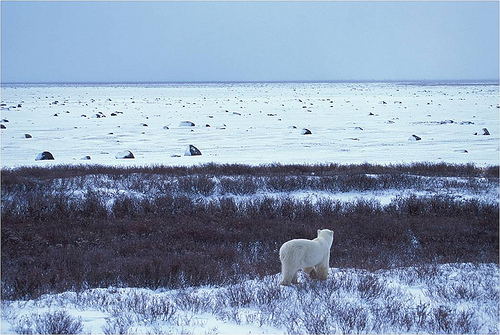Hybrids in the Arctic
 Hybridization has led to some of the unique, naturally-occuring species present today, such as the Mallard duck-American Black duck hybrid. Usually this natural process takes generations to produce a new distinct species; however, it is possible for hybrids to emerge within one generation. For example, interspecies breeding could be expedited due to environmental stressors caused by climate change. Species that would not normally come in contact with one another are being pushed into the same habitats—called hybrid zones—due to the removal of physical barriers, like glaciers and ice sheets.
Hybridization has led to some of the unique, naturally-occuring species present today, such as the Mallard duck-American Black duck hybrid. Usually this natural process takes generations to produce a new distinct species; however, it is possible for hybrids to emerge within one generation. For example, interspecies breeding could be expedited due to environmental stressors caused by climate change. Species that would not normally come in contact with one another are being pushed into the same habitats—called hybrid zones—due to the removal of physical barriers, like glaciers and ice sheets.
The arctic area in particular is experiencing an increase in hybridization due to habitat changes brought about by climate change. Everyone has seen the photographs of the polar bear clinging to a shrinking piece of ice – the shrinking ice is in fact what is encouraging the influx of non-native species into the Arctic.
Polar bears broke off as their own species hundreds of thousands of years ago because they were able to adapt to the colder climate and find food. Charlotte Lindqvist of the University of Buffalo found that polar bears were able to survive the last interglacial warming period; however, Lindqvist added, because the rate of current climate change is so much faster , these Arctic animals are unable to adapt quickly enough. Polar bears are essentially being hit with a 1-2-3 punch. Not only is their habitat diminishing, so too, are their food sources, —negatively impacting their breeding success. Research has shown that, due to lack of sustenance, female polar bears produce less healthy offspring, and the offspring that survive tend to be smaller in size. Additionally, polar bears may now have to deal with an increased number of grizzly bears.
Grizzly bears do not only pose a competitive threat to polar bears but a genetic threat as well. With melting Arctic ice, more polar bears are being forced to remain on land—meanwhile, the warmer temperatures and diverse food sources are enticing grizzlies to move further north. The cross-breeding of polar and grizzly bears could eventually lead to a complete loss of the unique genes of polar bears that have enabled the bear’s survival in the Arctic for so long. Grizzly bears are better suited for the warmer temperatures of the uplands of western North America—that is, compared to Arctic temperatures. With the increase in grizzly population in the Arctic due to warmer temperatures, and the decrease in polar bear population due to habitat constraints, potential cross-breeding could be more likely to occur. While the accepted rule of thumb is that hybrid offspring are unviable—or, unlikely to survive since they are unable to reproduce—there is support in a Nature study that viable polar-grizzly mixes have been produced, along with 34 other cases of marine mammal breeding with species that would not normally be in their original arctic habitat.
The issue with cross-breeding is that, while the first generation hybrids display strong characteristics and survival capability, progressive generations have diluted genes due to a constant shuffling of traits. Furthermore, genetic diversity is lost with each successive generation of cross-breeding, and the distinctive polar bear genes could be lost in the more prominent grizzly genes. The fact that viable polar-grizzly offspring exists supports the idea that interbreeding has been going on for decades now, according to the Nature study. Various other marine mammals are cross-breeding due to the removal of ice barriers uniting the previously isolated species. For example, bowhead whales have been found to mate with the rare North Pacific right whales, leading to decreasing pure right whale populations.
At least in the case of hybridization, climate change not only brings with it a change in landscapes, but a change in the distribution and migration of certain species as well. So the questions may not center on whether or not the hybrids are viable. Instead, is hybridization really a new phenomenon strictly linked to climate change? Or is this the same natural hybridization that has been going on for ages as species adapt to environmental changes? And how will these changes affect conservation efforts of polar bears?
Photo Credit: USFWS Alaska